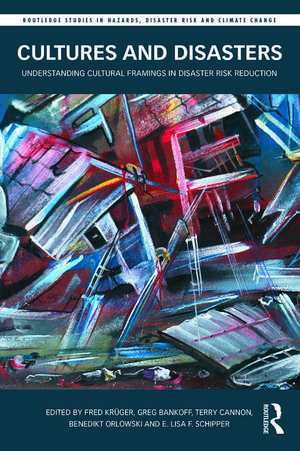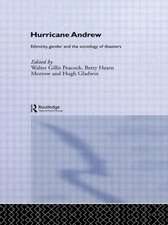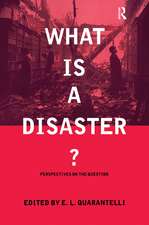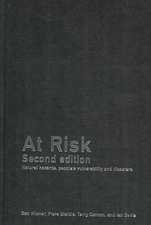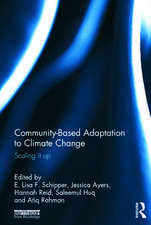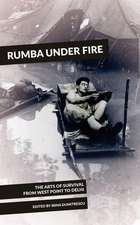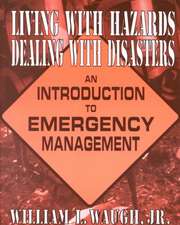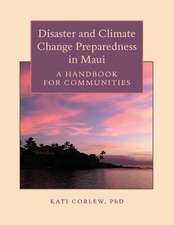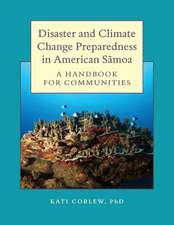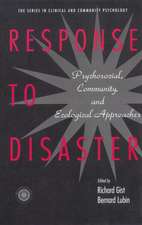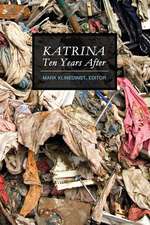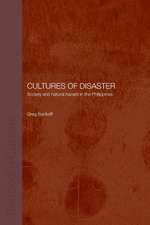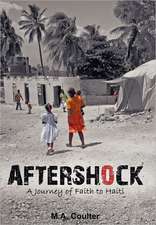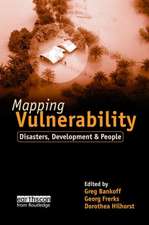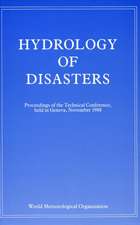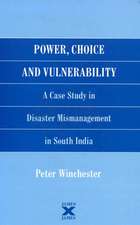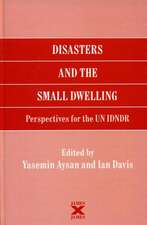Cultures and Disasters: Understanding Cultural Framings in Disaster Risk Reduction: Routledge Studies in Hazards, Disaster Risk and Climate Change
Editat de Fred Krüger, Greg Bankoff, Terry Cannon, Benedikt Orlowski, E. Lisa F. Schipperen Limba Engleză Paperback – 22 apr 2015
Culture and Disasters adopts an interdisciplinary approach to explore this cultural dimension of disaster, with contributions from leading international experts within the field. Section I provides discussion of theoretical considerations and practical research to better understand the important of culture in hazards and disasters. Culture can be interpreted widely with many different perspectives; this enables us to critically consider the cultural boundedness of research itself, as well as the complexities of incorporating various interpretations into DRR. If culture is omitted, related issues of adaptation, coping, intervention, knowledge and power relations cannot be fully grasped. Section II explores what aspects of culture shape resilience? How have people operationalized culture in every day life to establish DRR practice? What constitutes a resilient culture and what role does culture play in a society’s decision making? It is natural for people to seek refuge in tried and trust methods of disaster mitigation, however, culture and belief systems are constantly evolving. How these coping strategies can be introduced into DRR therefore poses a challenging question. Finally, Section III examines the effectiveness of key scientific frameworks for understanding the role of culture in disaster risk reduction and management. DRR includes a range of norms and breaking these through an understanding of cultural will challenge established theoretical and empirical frameworks.
| Toate formatele și edițiile | Preț | Express |
|---|---|---|
| Paperback (1) | 453.53 lei 6-8 săpt. | |
| Taylor & Francis – 22 apr 2015 | 453.53 lei 6-8 săpt. | |
| Hardback (1) | 1112.34 lei 6-8 săpt. | |
| Taylor & Francis – 24 apr 2015 | 1112.34 lei 6-8 săpt. |
Din seria Routledge Studies in Hazards, Disaster Risk and Climate Change
-
 Preț: 287.87 lei
Preț: 287.87 lei -
 Preț: 311.41 lei
Preț: 311.41 lei - 9%
 Preț: 934.96 lei
Preț: 934.96 lei -
 Preț: 153.08 lei
Preț: 153.08 lei -
 Preț: 296.85 lei
Preț: 296.85 lei -
 Preț: 278.13 lei
Preț: 278.13 lei -
 Preț: 465.39 lei
Preț: 465.39 lei -
 Preț: 389.66 lei
Preț: 389.66 lei - 21%
 Preț: 138.22 lei
Preț: 138.22 lei -
 Preț: 384.86 lei
Preț: 384.86 lei -
 Preț: 413.33 lei
Preț: 413.33 lei -
 Preț: 389.66 lei
Preț: 389.66 lei -
 Preț: 385.62 lei
Preț: 385.62 lei - 18%
 Preț: 1000.89 lei
Preț: 1000.89 lei - 18%
 Preț: 893.58 lei
Preț: 893.58 lei -
 Preț: 416.22 lei
Preț: 416.22 lei -
 Preț: 389.38 lei
Preț: 389.38 lei - 18%
 Preț: 1002.02 lei
Preț: 1002.02 lei - 17%
 Preț: 272.50 lei
Preț: 272.50 lei -
 Preț: 385.08 lei
Preț: 385.08 lei - 18%
 Preț: 1002.60 lei
Preț: 1002.60 lei -
 Preț: 385.02 lei
Preț: 385.02 lei -
 Preț: 400.10 lei
Preț: 400.10 lei -
 Preț: 420.76 lei
Preț: 420.76 lei - 18%
 Preț: 272.06 lei
Preț: 272.06 lei -
 Preț: 286.20 lei
Preț: 286.20 lei -
 Preț: 383.17 lei
Preț: 383.17 lei - 18%
 Preț: 1001.84 lei
Preț: 1001.84 lei - 15%
 Preț: 475.62 lei
Preț: 475.62 lei - 18%
 Preț: 895.32 lei
Preț: 895.32 lei - 17%
 Preț: 272.64 lei
Preț: 272.64 lei
Preț: 453.53 lei
Nou
Puncte Express: 680
Preț estimativ în valută:
86.79€ • 90.28$ • 71.65£
86.79€ • 90.28$ • 71.65£
Carte tipărită la comandă
Livrare economică 14-28 aprilie
Preluare comenzi: 021 569.72.76
Specificații
ISBN-13: 9780415745604
ISBN-10: 0415745608
Pagini: 298
Ilustrații: 12 black & white illustrations, 3 black & white tables, 2 black & white halftones, 10 black & white line drawings
Dimensiuni: 156 x 234 x 18 mm
Greutate: 0.55 kg
Ediția:1
Editura: Taylor & Francis
Colecția Routledge
Seria Routledge Studies in Hazards, Disaster Risk and Climate Change
Locul publicării:Oxford, United Kingdom
ISBN-10: 0415745608
Pagini: 298
Ilustrații: 12 black & white illustrations, 3 black & white tables, 2 black & white halftones, 10 black & white line drawings
Dimensiuni: 156 x 234 x 18 mm
Greutate: 0.55 kg
Ediția:1
Editura: Taylor & Francis
Colecția Routledge
Seria Routledge Studies in Hazards, Disaster Risk and Climate Change
Locul publicării:Oxford, United Kingdom
Public țintă
Postgraduate and UndergraduateCuprins
Introduction The Editors Section 1 The Culture of (De-)Constructing Disasters 1.1 Framing Disasters in the Global Village: Cultures of Rationality in Risk, Security, and News Kenneth Hewitt 1.2 Conversations in Catastrophe: Neoliberalism and the cultural construction of disaster risk Anthony Oliver-Smith 1.3 Design by Disasters: Seismic Architecture and Cultural Adaptation to Earthquakes Greg Bankoff 1.4 Learning from History? Chances, Problems and Limits of Learning from Historical Natural Disasters Gerrit Schenk 1.5 Disasters, Climate Change and the Significance of 'Culture' Terry Cannon Section 2 Cultural Linkages to Vulnerability 2.1 Cultures and contra-cultures: Social divisions and behavioural origins of vulnerabilities to disaster risk James Lewis 2.2 The cultural sense of disasters. Practices and singularities in the context of HIV/AIDS Klaus Geiselhart, Fabian Schlatter, Benedikt Orlowski, and Fred Krüger 2.3 Religion and Belief Systems: Drivers of Vulnerability, Entry Points for Resilience Building? E. Lisa F. Schipper 2.4 The deep roots of nightmares Andrew Crabtree Section 3 Unequal Risks: Staging and Reducing Disaster Risk 3.1 Celebrity Culture, Entertainment Values ...and Disaster David Alexander 3.2 Disaster Management Culture in Bangladesh: The Enrolment of Local Knowledge by Decision Makers Brian Cook 3.3 Cultures Role in Disaster Risk Reduction: Combining Knowledge Systems on Small Island Developing States (SIDS) Ilan Kelman, JC Gaillard, Jessica Mercer, Kate Crowley, Sarah Marsh, and Julie Morin 3.4 Culture, Gender and Disaster: From Vulnerability to Capacities JC Gaillard, Maureen Fordham and Kristinne Sanz 3.5 A Culture of Resilience and Preparedness the Last Mile case study Tsunami Risk Padang City, Indonesia Joern Birkmann Neysa Setiadi and Georg Fiedler 3.6 Participative Vulnerability and Resilience Assessment and the Example of the Tao People (Taiwan) Martin Voss and Leberecht Funk
Notă biografică
Fred Krüger is Professor of Geography at the University of Erlangen-Nürnberg, Germany.
Greg Bankoff is Professor of Modern History at the University of Hull, UK.
Terry Cannon is a Research Fellow at the Institute of Development Studies, UK.
Benedikt Orlowski is a Research Fellow at the Institute of Geography, University of Erlangen-Nürnberg, Germany.
E. Lisa F. Schipper is a Research Associate at the Overseas Development Institute, London, UK, and Associate at the Stockholm Environment Institute, Sweden.
Greg Bankoff is Professor of Modern History at the University of Hull, UK.
Terry Cannon is a Research Fellow at the Institute of Development Studies, UK.
Benedikt Orlowski is a Research Fellow at the Institute of Geography, University of Erlangen-Nürnberg, Germany.
E. Lisa F. Schipper is a Research Associate at the Overseas Development Institute, London, UK, and Associate at the Stockholm Environment Institute, Sweden.
Recenzii
"Cultural profiles play a crucial and often underestimated role not only in the science, but also in the practice of risk and crisis management. This discussion can’t be limited to the large scale patterns between societies and continents, but should include the diversities within a society or geographical region, creating awareness on the range of perspectives, attitudes and priorities within different societal sectors. It is one of the major strengths of this very timely book that it addresses the many ways and levels in which cultures can influence disaster risk."
Professor Jakob Rhyner, UNU-EHS Bonn
"At last … the long-awaited, definitive book that explores the complexities of culture and disaster risk. Cultures and Disasters is a highly ambitious work that interprets the subtle dimensions of the management and reduction of risk. The authors consider diverse questions that include the philosophy of risk, politics and power relationships, local knowledge and learning, social divisions, religion, celebrity culture, coping strategies and adaptive behaviour. Researchers, students and practitioners will all benefit richly from this splendid work produced by five eminent editors and over twenty international experts in the field."
Ian Davis, Visiting Professor in Disaster Risk Management in Copenhagen, Lund, Kyoto and Oxford Brookes Universities
"The Sendai Framework for Disaster Risk Reduction 2015–2030 over the next 15 years aims to achieve 'the substantial reduction of disaster risk and losses in lives, livelihoods and health and in the economic, physical, social, cultural and environmental assets of persons, businesses, communities and countries’. This timely book with its case studies enable a wider understanding of the cultural issues surrounding disasters."
Virginia Murray, Public Health England
"This collection of essays provides a much needed intervention in the field of disaster risk reduction. Its contributors represent some of the most eminent scholars in the field, providing insight into the socially embedded nature of risk and the contextual nature of people’s perceptions, interpretations, and reactions to hazards."
Zehra Zaidi, Natural Hazards Observer
"Both a book with highly usable chapters for students and innovative chapters that further the research agenda, the editors are to be commended for taking on such a challenge and providing the research community with a go-to book for anyone approaching the sticky subject of culture and disasters."
Olivia Wilkinson, Journal of International Humanitarian Action
Professor Jakob Rhyner, UNU-EHS Bonn
"At last … the long-awaited, definitive book that explores the complexities of culture and disaster risk. Cultures and Disasters is a highly ambitious work that interprets the subtle dimensions of the management and reduction of risk. The authors consider diverse questions that include the philosophy of risk, politics and power relationships, local knowledge and learning, social divisions, religion, celebrity culture, coping strategies and adaptive behaviour. Researchers, students and practitioners will all benefit richly from this splendid work produced by five eminent editors and over twenty international experts in the field."
Ian Davis, Visiting Professor in Disaster Risk Management in Copenhagen, Lund, Kyoto and Oxford Brookes Universities
"The Sendai Framework for Disaster Risk Reduction 2015–2030 over the next 15 years aims to achieve 'the substantial reduction of disaster risk and losses in lives, livelihoods and health and in the economic, physical, social, cultural and environmental assets of persons, businesses, communities and countries’. This timely book with its case studies enable a wider understanding of the cultural issues surrounding disasters."
Virginia Murray, Public Health England
"This collection of essays provides a much needed intervention in the field of disaster risk reduction. Its contributors represent some of the most eminent scholars in the field, providing insight into the socially embedded nature of risk and the contextual nature of people’s perceptions, interpretations, and reactions to hazards."
Zehra Zaidi, Natural Hazards Observer
"Both a book with highly usable chapters for students and innovative chapters that further the research agenda, the editors are to be commended for taking on such a challenge and providing the research community with a go-to book for anyone approaching the sticky subject of culture and disasters."
Olivia Wilkinson, Journal of International Humanitarian Action
Descriere
Why did the people of the Zambesi Delta affected by severe flooding return early to their homes or even choose to not evacuate? How is the forced resettlement of small-scale farmers living along the foothills of an active volcano on the Philippines impacting on their day-to-day livelihood routines? Making sense of such questions and observations is only possible by understanding how the decision-making of societies at risk is embedded in culture, and how intervention measures acknowledge, or neglect, cultural settings. The social construction of risk is being given increasing priority in understand how people experience and prioritize hazards in their own lives and how vulnerability can be reduced, and resilience increased, at a local level.
Culture and Disasters adopts an interdisciplinary approach to explore this cultural dimension of disaster, with contributions from leading international experts within the field.
Culture and Disasters adopts an interdisciplinary approach to explore this cultural dimension of disaster, with contributions from leading international experts within the field.
